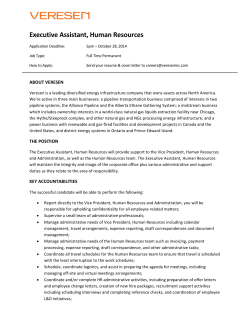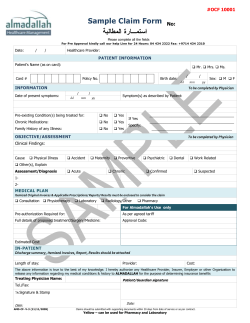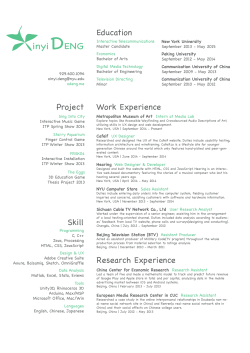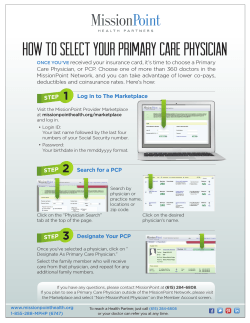
Medical Assisting PowerPoint to accompany • Booth • Pugh • Thompson • Whicker
PowerPoint® to accompany Medical Assisting Chapter 11 Second Edition Ramutkowski • Booth • Pugh • Thompson • Whicker Copyright © The McGraw-Hill Companies, Inc. Permission required for reproduction or display. 1 Telephone Techniques Objectives 11-1 Explain how to manage incoming telephone calls. 11-2 Explain the importance of communication skills. 11-3 Compare the types of calls the medical assistant handles with those the physician or other staff members handle. 11-4 Describe how to handle various types of incoming calls from patients and from others. 11-5 Discuss the importance of proper telephone etiquette. 2 Telephone Techniques (cont.) Objectives 11-6 Describe the procedures for taking telephone messages. 11-7 Explain how to retrieve calls from an answering service. 11-8 Describe the procedures for placing outgoing calls. 11-9 Explain the function of telephone triage in the medical office. 11-10 Explain the uses of a facsimile machine in the medical office. 3 Using The Telephone Effectively Good telephone techniques leave the patient with a positive impression of: •You •The Physician •The Practice Good Telephone Management Shows That: Poor Telephone Management Results In: • Staff is caring • Staff is attentive • Staff is helpful • Bad feelings • Misunderstanding • Unfavorable impressions 4 Using The Telephone Effectively The 5 C’s of Communication 5 Managing Incoming Calls Calls should be answered promptly Greet the caller with the medical office name and your name Be courteous, calm, and pleasant Identify the nature of the call If the caller does not give his/her name, ask for it Use the caller’s name when communicating and saying goodbye at the end of the call 6 Managing Incoming Calls (cont.) Screening Calls Follow the office policy to determine: Calls that should be put through immediately Calls that should be returned later Calls that should be handled by another staff member other than the physician Generally, 3 types of calls received in the office pertain to: 1) Administrative Issues 3) Clinical Issues 2) Emergency Calls 7 Managing Incoming Calls (cont.) Routing Calls Calls Handled By the Medical Assistant: Appointments Billing Inquiries Insurance Questions Diagnostic Reports (lab & X ray) Other Reports from patients and hospitals, etc. Referral Requests Prescription Renewals (physician must approve) Patient Complaints 8 Managing Incoming Calls Routing Calls (cont.) Calls Requiring the Doctor’s Attention: Emergency calls Calls from other physicians Patient requests regarding test results Patient requests to discuss their symptoms Requests for prescription renewals Personal calls A routing list specifies who is responsible for handling certain types of calls. 9 Apply Your Knowledge The medical assistant is just returning from lunch, and the office telephone is ringing. When the medical assistant answers, the caller interrupts her greeting and states “No, do not put me on hold again, I have been on hold for 10 minutes!” How should the medical assistant respond to this caller? 10 Apply Your Knowledge - Answer The medical assistant is just returning from lunch, and the office telephone is ringing. When the medical assistant answers, the caller interrupts her greeting and states “No, do not put me on hold again, I have been on hold for 10 minutes!” How should the medical assistant respond to this caller? Remain calm and allow the caller to express his/her concerns. Apologize for any inconvenience and inform the caller that you would like to help. It is not a good idea to attempt to shift the blame by telling the caller that you were just returning from lunch, instead put effort into solving the concern. 11 Types of Incoming Calls Calls From Patients Medical Assistant Role Appointments Billing Inquiries Diagnostic Reports Questions About Medications Make or change appointments as needed Clarify bill or charges Assist to set-up payment arrangements if possible If information is given be sure to document it in the record Get approval for renewals Answer questions about medications 12 Types of Incoming Calls (cont.) Calls From Patients Medical Assistant Role Reports of Symptoms Progress Reports Request for Advice Complaints Apologize Listen carefully & document Schedule appointment as needed Route follow-up calls to the physician Document call in patient record Do not give any medical advice for any inconveniences Remain calm & listen then follow 13 through to resolve issue Types of Incoming Calls (cont.) • Must be immediately routed to the physician • Includes serious or life threatening conditions such as: Severe bleeding Drug Reaction Injuries Poisoning Suicide Attempts Severe Burns Loss of Consciousness 14 Types of Incoming Calls (cont.) Attorneys Other Physicians Follow office guidelines carefully Never release any patient information unless the physician authorizes you to do so Route calls to the physician Do not disclose any patient information Salespeople Request that information be mailed to you about new products Pharmaceutical representatives may be seen by the physician 15 Apply Your Knowledge A medical assistant working in a large surgical medical practice answers the telephone and the caller states “Hi, I’m Dr. X., did Dr. C. perform Mrs. A. W.’s surgery yesterday?” How should the medical assistant respond? 16 Apply Your Knowledge - Answer A medical assistant working in a large surgical medical practice answers the telephone and the caller states “Hi, I’m Dr. X., did Dr. C. perform Mrs. A. W.’s surgery yesterday?” How should the medical assistant respond? It would be best for the medical assistant to request that this physician hold to speak with the physician. This could be someone else, and you are not at liberty to disclose any information. You should not even acknowledge whether Patient “A. W.” did or did not have surgery. 17 Using Proper Telephone Etiquette Your Telephone Voice Speak directly into the receiver. Be friendly & convey interest to the caller. Use non-technical language but never use slang. Use a normal tone but attempt to vary your pitch. Pitch is the high and low level of your speech. 18 Using Proper Telephone Etiquette (cont.) Pronunciation • Saying words correctly • If the name is difficult to pronounce, ask the patient how it is pronounced Pronunciation versus Enunciation Enunciation • Saying words in a clear and understandable manner • Eating, chewing gum, and incorrect placement of the phone decreases enunciation 19 Making a Good Impression Courtesy • Project an attitude of helpfulness • Always refer to the caller by name • Thank the caller before hanging up Giving Undivided Attention • Give the caller the same level of attention as if he or she were right in front of you • Listen attentively to get accurate information Putting a Call on Hold • Always allow the caller to state the purpose of the call prior to placing the caller on hold • If you think the wait will be lengthy, offer to call back instead 20 of placing them on hold Making a Good Impression (cont.) Handling Difficult Situations Remembering Patient Names If the call is not an emergency, and you are in the middle of an urgent situation, offer to return the call. Callers feel important when their names are remembered. Checking for Understanding Ask questions to ensure that the caller understands what you have discussed and that you understood them. 21 Making a Good Impression (cont.) Communicating Feelings Try to communicate an understanding of the caller’s feelings (empathy.) Callers tend to have a better perception of the office if empathy is communicated. Ending the Conversation Summarize important points. Thank the caller for calling. Allow the caller to hang up first. 22 Taking Messages Always keep a pen and paper near the telephone, so you are prepared to record the message. Contents of Telephone Message Pads TO:____________________________________ Date__________ Time_____________ Message FROM:_________________________________ Telephone ( )________________extension____ Message Details: Your Name or initials 23 Taking Messages (cont.) The Telephone Log Ensuring Correct Information A spiral-bound perforated message book is often used to record messages. The top copy or original is given to the message recipient, and a copy is kept in the book for future reference. Get the correct spelling of the caller’s name and get date of birth for patients having the same name. Maintaining Patient Confidentiality You must maintain confidentiality with written telephone messages and do not repeat any confidential information over the telephone. 24 Apply Your Knowledge Find the missing data on this message form. Contents of Telephone Message Pads TO: Dr. “X” Date 12-03-05 Time 0930 Message FROM: Dr. Telephone (111) 111- 0000 Message Details: Please call before 2pm today. extension 010 25 Apply Your Knowledge - Answer Find the missing data on this message form. Contents of Telephone Message Pads TO: Dr. “X” Date 12-03-05 Time 0930 Message FROM: Dr. (Which doctor???) Telephone (111) 111- 0000 extension 010 Message Details: Name or initials of person Please call before 2pm today. taking the message 26 Telephone Answering Systems Office telephone systems can vary from a single telephone line to a multi-line system. One of the medical assistant responsibilities may be to retrieve information from the answering service. Common equipment and services used in the medical office includes: Automated voice mail. Answering machine. Answering service. 27 Placing Outgoing Calls Locating Telephone Numbers • Verify accuracy of the number prior to calling • Refer to office directories to locate numbers • Use directory assistance by dialing (1-800-area code555-1212) as a last option since a fee is charged for this service Applying Your Telephone Skills Arranging Conference Calls • Plan • Allow at least one minute or 8 rings • Identify yourself & ask if time is good for person • Medical Assistants may need to schedule calls between several people • Remember the different time zones • Suggest several time slots as options 28 Telephone Triage Telephone triage is used as a process of deciding what action to take. • Telephone staff are given guidelines to handle common conditions Learning The Triage Process • Telephone staff must determine if caller requires • Telephone staff cannot additional care diagnose or treat a patient’s problem • Specific information is obtained such as name, age, symptoms, anxiety, etc. 29 Telephone Triage (cont.) Level of Severity Categorizing The Problem Manage by telephone Manage in office Send patient to emergency care facility Advise patients that the recommendations are based on the symptoms they described and are not a diagnosis. 30 Telephone Triage (cont.) Taking Action • Telephone triage staff use the guidelines to determine the course of action needed based on patient symptoms. Telephone situations must be handled correctly to protect the health and safety of the patient. 31 Apply Your Knowledge The medical assistant has been informed that the office physician and the consulting physician must speak with the daughter of an unresponsive patient recently diagnosed with a terminal condition. The daughter resides out-of-town. What would you do in this situation? 32 Apply Your Knowledge - Answer The medical assistant has been informed that the office physician and the consulting physician must speak with the daughter of an unresponsive patient recently diagnosed with a terminal condition. The daughter resides out-of-town. What would you do in this situation? This situation requires that three parties be able to communicate at the same time to each other. Setting up a conference call would be most plausible. 33 End of Chapter 34
© Copyright 2025














